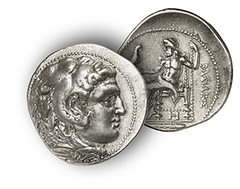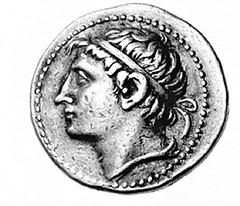
PREV ARTICLE
NEXT ARTICLE
FULL ISSUE
PREV FULL ISSUE
THE COINS OF ANCIENT SPARTAMike Markowitz has another great article on ancient coins in CoinWeek,
published September 23, 2014 . The topic is the coins of Sparta. Here's a short excerpt, but be
sure to read the complete version on the CoinWeek site. -Editor
Hundreds of different Greek cities issued coins between the birth of coined money around 650 BCE and the end of Greek civic coinage some time after 300 CE. The apparent exception was Sparta. Many serious collectors of ancients have never seen a Spartan coin. Some believe Sparta struck no coins at all. As usual in Classical Numismatics, however, there is a “Yes, but...” lurking in the weeds. Sparta issued coins, in small quantities, well after it had ceased to be a major power in the affairs of the Greek world. While other Greeks experimented with exotic political innovations like democracy, oligarchy and tyranny, conservative Sparta clung stubbornly to its archaic dual monarchy: two equal kings from different dynastic families, the Agiads and the Eurypontids. It made sense to have a spare king on hand, considering the high risk that at least one king in every generation would die in battle.
Areus also issued rare silver obols, suggesting a need for small change. Fighting the Macedonians outside Corinth, Areus was killed in 265 BCE.
Cleomenes also issued anonymous bronze coins. This suggests that Sparta’s domestic economy had evolved to function more like other Greek cities, with a need for small change in daily life. To read the complete article, see:
Wayne Homren, Editor The Numismatic Bibliomania Society is a non-profit organization promoting numismatic literature. See our web site at coinbooks.org. To submit items for publication in The E-Sylum, write to the Editor at this address: whomren@gmail.com To subscribe go to: https://my.binhost.com/lists/listinfo/esylum All Rights Reserved. NBS Home Page Contact the NBS webmaster 
|

